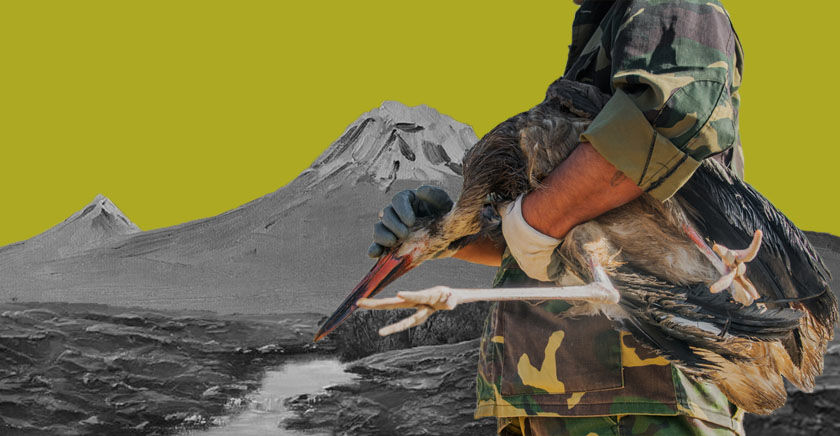
All images by Sofia Bergmann.
The smell of oil was piercing, and the sound of volunteers singing “Bari Arkeel” (Kind Stork) to the birds they were cleaning embodied the essence of strength in community. Some even shed tears at the site of the aimlessly stumbling storks trying to walk and fly.
“Good luck, stork, good stork / Stork, praise me with joy …” they sang the folk song to the White Stork. For over a month now, countless of these birds have been discovered covered in oil after swimming in their natural habitat - the streams and canals of the Ararat Valley. It is believed that the oil was generated from fish remains, mercilessly dumped by nearby fisheries. The volunteers spend hours in the blistering sun and oil, trying to make even a small difference.
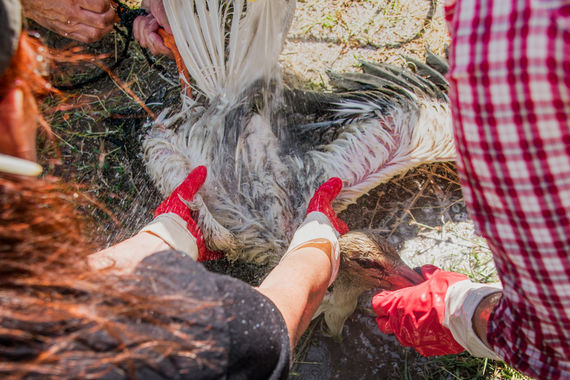
“The storks would have been dead by tomorrow if we hadn’t found them today,” said Artur Mkrchyan, mayor of the village of Hovtashen. Residents of the village were the first and most active in this pursuit. He is the only Mayor in the affected region who has voluntarily dedicated time and effort in finding, cleaning and feeding the storks, while nearby villages have also become more involved. Along with him, the volunteers, locals and Dr. Karen Aghababyan have been the White Storks’ saving grace. Aghababyan is the director of the Towards Sustainable Ecosystems NGO, legal advisor to the Minister of Environment, Former Research Assistant Professor and Head of Environmental Lab at the American University of Armenia, and contributes to several bird protection efforts.
Irina Ghaplanyan, Deputy Minister of the Environment, who was also at the cleanup in Hovtashen said, “We don’t have an institutional system [for this sort of procedure.]” Aside from governmental measures that are beginning to take place, the initial help came from local residents simply motivated by their love for the bird, which goes beyond just the environmental.
White Storks are vital to these communities. They prey on pests that could be detrimental to the agricultural fields that make up the region. Storks characteristically nest near humans and symbolize luck, fertility, prosperity and also provide a large platform for environmental education in these communities thanks to Dr. Aghababyan’s contribution. Moreover, they are part of the great migration to Africa, and their behaviour can indicate the state of the wetlands for scientific research. The White Stork’s peril implies not only a threat to the species, but to the people as well.
On Sundays, enthusiastic volunteers from the village of Hovtashen and Yerevan have been cleaning the birds with dish soap in plastic bins on a field filled with kettle-heated water, some technical training, and Mt. Ararat as their witness. In fact, the Ararat region provides 40 percent of Armenia’s agriculture, has the largest number of White Storks in the country, and is home to most of the fisheries in Armenia (currently at about 135). A perfect storm one could say, because many traces point to some fisheries dumping oily and toxic remains into the nearby streams during their mass exports (first signs came in 2017, 2019 being the worst year so far.) This waste ends up in swamps where the Storks scavenge for food, impacting Ararat’s agricultural communities. Dr. Aghababyan thinks the reason for this large quantity of waste could be related to the fisheries gutting too many fish at once.
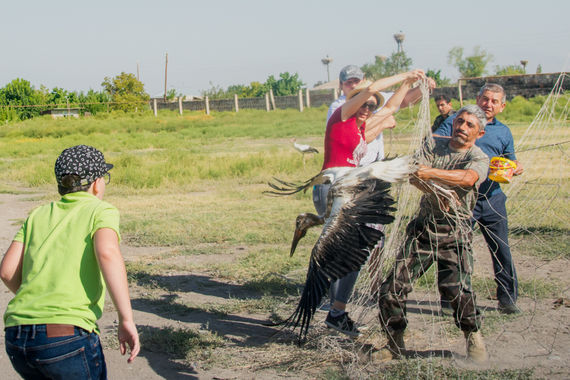
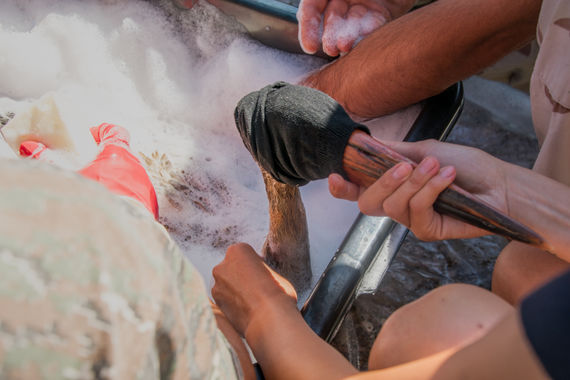
The Ararat region being Armenia’s bread basket, a threat to agriculture from pests such as mice which storks normally eat, can create serious problems. While the storks are bound for Africa in mid to late September for their winter migration, “about 250-300 individuals [storks] continue their stay in Armenia” according to the Armenian bird census. This explains why almost every single telephone pole, chimney and rooftop in Hovtashen holds a stoic and enormous stork nest. These nests are a staple pride and joy of Hovtashen, bare the future of the Great Migration, but also bare a precedent for environmental education and scientific research.
Dr. Aghababyan is at the forefront of this precedent, and has “initiated several eco clubs in schools” as well, creating an environmental consciousness which did not exist before, he says. Not only has he helped organize stork cleanings alongside locals, but has also been in close contact with the stork-loving communities since 2007. He started an organization called Nest Neighbors, which is supported by the Whitley Fund for Nature and involves around 1,000 families who live among the storks and report their health, behaviour, number of nestlings, collisions with telephone wires and more. He uses this information for research, and the monitoring observations are registered in a large scientific database. He also recalls that some of the young kids he worked with in 2007 have now grown to become active in conservation efforts. While Hovtashen’s Mayor has been the most involved out of the ten other affected villages (Hovtashat, Hayanist, Zorak, Dashtavan, Sipanik, Sayat-Nova, Darakert, Darbnik, Noramarg, Nizami), Nest Neighbors has been very active and informed in all these cases. “In fact the first emergency call [for the oil-covered storks] came from Nest Neighbors,” he said. Thanks to his extensive work with the White Stork and the communities, the species itself is generally in good standing, with increasing number of nestlings over the years.
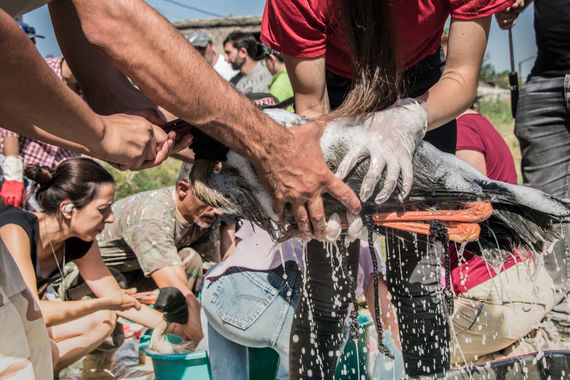
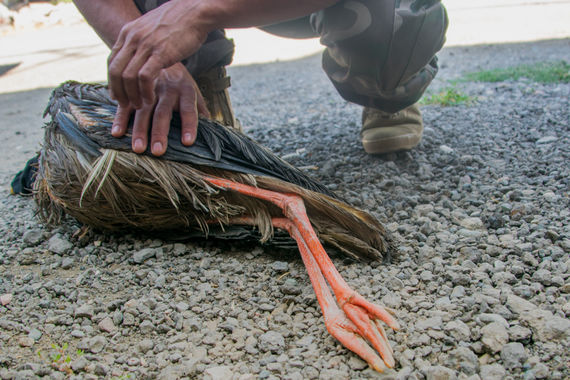
Why storks? Storks scavenge rather than hunt for their food unlike herons for example. They often feed in marshes, and therefore have been gravitating towards the oily swamps. Volunteers involved in this effort have been primarily catching younger storks because they are more curious and susceptible to rummaging in the oily swamp, and are also easier to catch and feed because they are less afraid of humans. Many of the adult storks who swam in the oil have likely died because they avoid being approached or fed by people. Feeding is key, because the storks have been unable to eat on their own before and right after being cleaned. That is why Hovtashen’s mayor Mkrchyan “feeds the birds from his own pocket” as Dr. Aghababyan says.
“I come with my deputy and up to midnight we survey the village looking for storks, but many have disappeared...There are many in the fields that are going to fall prey to wild animals,” said Mkrchyan as his son Suren was washing off oil after wading into the oily swamp to save yet another stork. On many occasions, locals have swam in the oil to rescue the birds. “This is the function of inspection,” adds Aghababyan regarding the need for an official inspection system. Nevertheless, the Ministry of Environment has allocated budget for supplies, and there are currently at least 40 well-trained volunteers ready for emergency calls. Dr. Hayk Martirosyan, Former Adviser to the Chief Justice of the Supreme Court of Armenia also got involved, and traveled to Hovtashen from New York when he heard about the issue. He raised awareness to gather funds and supplies from his connections in the States.
On August 22––over a month after the incident––drones from the Forest Monitoring Center and from volunteers who also have drones, began to survey the area mapped out by a team of volunteers. But only one injured stork was found and was not affected by the oil: Aghababyan believes this may be because many have already died, and others can still fly even with some oil, making it impossible to catch and clean them. As of now, 20 storks have been captured and cleaned and are now being trained not to rely on humans for food; some are also able to fly up to 50 meters as of very recently. Aghababyan has advised all volunteers not to feed the storks so they become self sufficient again.
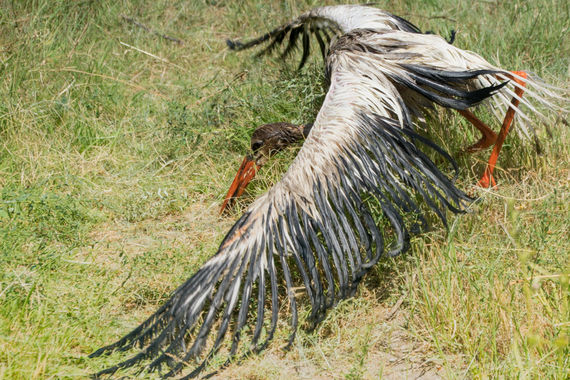
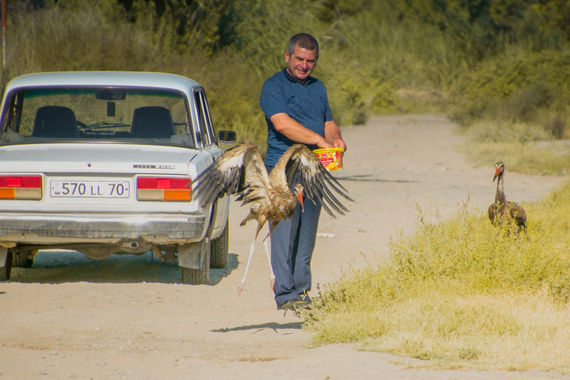
Cleaning them is not a simple task either. “If you don’t wash them properly and do not brush in the right line, then the feathers are destroyed,” explained Dr. Aghababyan. Brushing in circles and brushing too harshly can ruin their lining, potentially rendering it impossible for the birds to fly. Volunteers use battery-less facial cleansing brushes and their hands––some wearing gloves and others not. The heads of the birds must be kept stable by holding them by the beak, and the faces and eyes are covered as well to protect them from getting poked and contaminated with soap. This too requires close monitoring among the chaos, as one small bin has up to five or six volunteers washing the birds. If the water is not around 40 degrees celsius, the birds can be exposed to hypothermia according to Aghababyan, because the oil-damage has hindered their ability to maintain the right body temperature. When the device used to heat the water broke before the last big cleaning session on August 11, two kettles were brought from locals’ kitchens. After being washed, the storks must be stabilized as they stumble and fall when they try to walk. Most of the birds gather in the sun and flap their wings attempting to dry themselves and fly, which takes a few hours. In the following days they remain among the locals and rely on the Mayor to feed them. Now after over a month, the storks follow him around as though they are his pets. While this is not the job of a mayor, Mkrchyan does it with a smile on his face as he tries to preserve a part of his village’s identity.
Ghaplanyan assures that the Ministry of Environment is working on preventive mechanisms and punitive measures regarding not only the wetlands but mining and wildlife. She adds that Armenia has a long lasting “polluter pays” mentality as she calls it, meaning that a fine is often sufficient compensation. Upon the collapse of the USSR, many newly independent states like Armenia adopted Ecocide: a penal code which allows accountability for large scale environmental emergencies such as this one, but this policy “has never been used. There is no precedent” says Ghaplanyan, adding that things will change in the near future.
“It appears that it is not just one fish farm that is polluting, it is a pretty wide scale issue in that region,” said Dr. Aghababyan. But this is not the general consensus. Artur Beglarian is head of the Wildlife Management Division within the Environmental Protection and Mining Inspection Body which oversees the preservation, protection, and reproduction of wildlife. He emphasizes that it is not 100 percent certain that the oil is coming directly from the fish farms. This is why Armenia’s Nature Protection and Soil Inspectorate has “sent stork samples to the Institute of Zoology at the National Academy of Sciences to be inspected, who confirmed that the source of the oil is from food production," says Beglarian. Based on the lab results sent to the Prosecutor General’s Office, a criminal investigation has been launched which will enforce the existing regulations on the parties responsible, according to Beglarian. “We will try to use our lobbying power to make sure [the investigation] goes through,” added Ghaplanyan. Findings from samples taken on July 23 from the Hrazdan River in the Khachpar village showed organic matter, phosphate and ammonium ion contamination. While the first major source of pollution which was a canal has been cleaned, a second canal has been found and will be cleaned as well.

Beglarian also says that each fish farm fills out a “passport where they log in the amount of hazardous and non-hazardous waste that they generate.” The fisheries are then supposed to send the hazardous waste to one of two licensed waste destruction companies, who dispose it after proper treatment. Regarding the White Stork, Beglarian says that “there is no specific law protecting the storks,” adding that the law is targeted towards protecting all species with particular attention to those in the red book (severely endangered), which storks currently are not. In terms of future prevention, Beglarian says that the amount of energy and the “amount of coverage this issue has gotten, will help prevent this from happening again.” All parties involved in the process "work with the international community to more effectively address the issue."
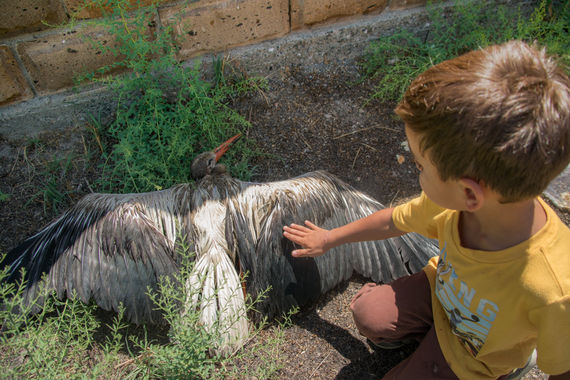
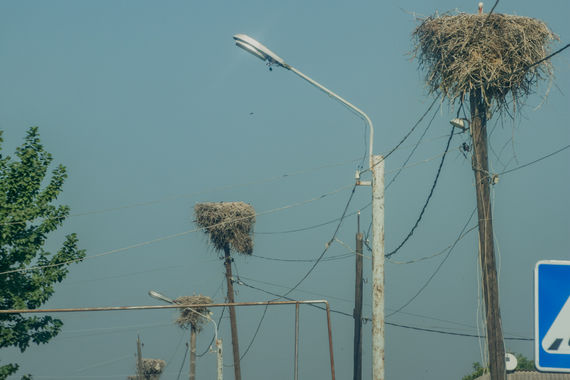
The fish farms face other problems as well. The contents of the fish remains which are likely killing the storks, could in fact be used for fish fodder and fish meal which are in high demand, said Dr. Aghababyan. This is because the bycatch (fish left in nets) from big commercial fishing is typically used for fodder––but overfishing has caused a decline in the availability of commercial bycatch, effectively creating this high demand. The fisheries in Ararat are not educated about this demand however, and also do not have the proper reprocessing procedures and equipment to turnover their waste. Nevertheless, Dr. Aghababyan is in contact with one fishery who has expressed interest. “We have found a potential buyer for the fish meal, so now we are searching for the loan to begin the process,” as well as a business plan, he said.
The fisheries also have brought the Ararat Valley to the brink of disaster by partially or mostly depriving arable lands and vegetable gardens of water for irrigation. This is because they deplete the vital underground aquifers for their fish ponds and let the wells run. Back in 2013, groundwater abstraction hit record levels, rising to 1.7 billion cubic meters, 65 percent of which was used for fish farming.Fisheries do this because the temperatures underground are perfect for certain fish, and the lack of resources and regulation compels them to extract the ideal-temperature water instead of adjusting it themselves.
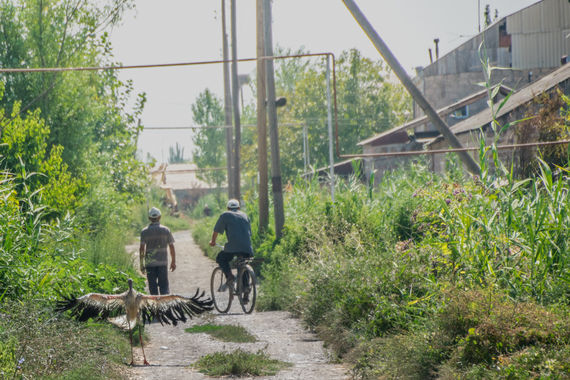
Another threat to the Storks and wetlands of Ararat is the Millenium Challenge Corporation donating $100 million to improve irrigation and decrease rural poverty in Armenia, which is due to launch soon––a plan however, that potentially threatens draining the wetlands. “At current, we will do a careful assessment of the project” Aghababyan said. A similar drainage project was launched in 2008, and restrictions on drainage to ensure wetland safety were enacted with Aghababyan’s help.
Five cases of White Stork poaching have also recently been recorded according to Aghababyan. “All of the people are very disappointed” and the main source is unknown, but the cases are also being investigated, he said.
Nevertheless, this state of emergency regarding the oil-covered storks has not only generated great public interest, but has revealed a particularly strong correlation between the local communities and the storks.
While Armenia faces other environmental issues, the significance of the White Stork on the people of Ararat has proved to generate a unique urgency and momentum that is also very personal and emotional. Most importantly however, Dr. Aghababyan emphasizes the strength in community. “The success of this work was possible only because of cooperation between the public and the government sector,” he said.



